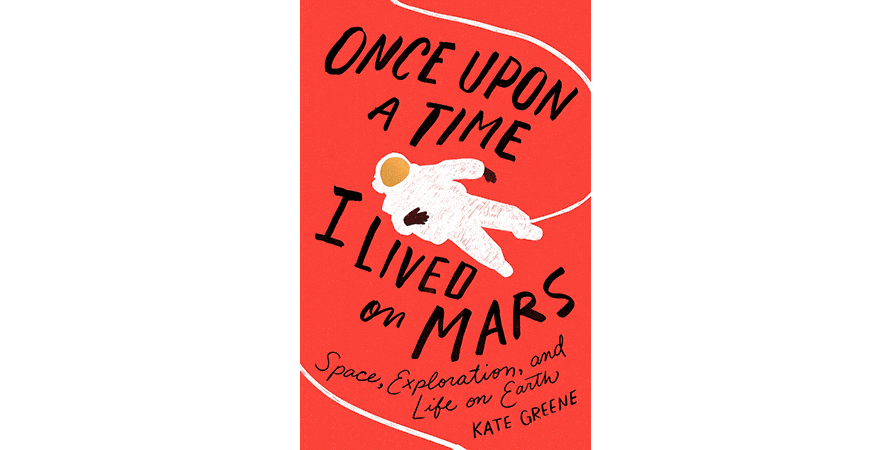Category: Non-Fiction
Reviewed by: Peter Spasov
Title: Once Upon a Time I Lived on Mars: Space, Exploration, and Life on Earth
Author: Kate Greene
NSS Amazon link for this book
Format: Hardcover/Kindle/Audiobook
Pages: 240
Publisher: St. Martin’s Press
Date: July, 2020
Retail price: $27.99/$14.99/$16.93
ISBN: 978-1250159472
This is a deeply personal book from former analog astronaut Kate Greene. In 2013 she joined five others to operate a simulated Mars mission, NASA’s Hawai’i Space Exploration Analog and Simulation, or HI-SEAS. She begins with the importance of analog missions, which are akin to dress rehearsals for actual space missions. Such simulations probe astronaut psychology and sociology in order to cope with long journeys far away from Earth. Much of the book offers the author’s views on society and human motivations within a world about to become a space faring civilization. Nonetheless Greene sprinkles gems throughout about the hard lessons learned from both actual and analog space missions, as it pertains to human behaviour.
The introduction begins with a story whose lesson is that simulations are important to work through unexpected glitches. Greene then lays out the impact of food on crew psychology, the role of birthdays and other celebrations, the months spent with the same people, same clothes, same habits and so on, all within a cramped indoor space. Imagine four months living in a walk-in closet while never going outdoors. Armed with her experience as an analog astronaut, as well as a science writing background, the author asks what type of humans would willingly put themselves through these conditions.
In the chapter about Astro-Gastronomy we learn of issues with odors in zero gravity and how this impacts taste. There is the phenomenon of menu fatigue and the creativity crew expends to invent culinary creations with whatever is on hand. Greene also mixes in space history and her personal life-on-Earth history on the subject.
The chapter on boredom highlights a psychological discussion of its benefits and pitfalls. Indeed, with time on hand, astronauts are freed up to do things without dealing with bills, commutes, shopping and so on. As well, Greene tells the history of polar explorers handling conditions of sensory deprivation, monotony and isolation. Then the author warns that an actual Mars mission could experience disaster borne of boredom.
Following chapters offer numerous personal anecdotes concerning the author, her acquaintances, and other crew of the analog mission, as well as some NASA history. Green talks about experimentation on humans in the USA, as well as for space missions. For instance, subjects wore pyjamas until they could no longer do so, since there’s no laundry in space. Then there are opinions about human body adaptations, terrestrial architecture, spaceship living quarters, Mars and Earth.
The heart of the book is the chapter on isolation. It begins with figuring out what to pack for the trip and how to handle sickness, death and other personal emergencies. Things to deal with include alienation, group culture, and fitting in and the ‘Us vs. Them’ phenomenon, the latter about a partisan world where group members support each other against those of another. It is here where the author becomes most philosophical and personal. She poses questions about what it means to be a human being alive, alone and unable to achieve contact with others in this universe. How does one determine what it means to be so isolated on our island Earth and yearn to connect to something beyond?
Later, Greene illustrates her personal experience of long-distance emails with her mother as well as listing potential books one might bring. Some crew (and loved ones on Earth) will need to message daily whereas others will find it more of a burden. The challenge increases with Earth-Mars communication due to time lags. Martian crews will require greater autonomy.
There is a chapter about dreams where the author muses on eclectic topics such as mythology, earlier analog missions, the iconic Earth-rise photograph, the Tesla Roadster and space tourism, among other topics. The next chapter covers testing 3D printers, assessing spacesuit trainers and wearing workout shirts to the point of disgust. Then another chapter offers controversial facts about funding. For instance, a crewed Mars mission costs a fraction of what the USA government spent on ‘emergency funding’ to the finance industry in 2011. In the final chapter, Greene paints an imaginative analog of human progress viewed like the exits and airlocks of spacecraft, evoking the stillness prior to a momentous event.
The general writing style mixes personal experience, history, opinions and philosophizing on related subjects—and life in general. Variations of some topics are repeated in other chapters. In particular, Greene’s autobiographical expositions centre on her brother’s death, her aging parents and the ending of her marriage. The author’s political sentiments also leak out through some of her commentary of terrestrial events.
Personally I found the book both informative and frustrating. It is loaded with relevant facts and stories, yet there is also the sense of rambling and, perhaps, excessive self reflection. It is a book about space exploration differing from others. Nevertheless veteran space enthusiasts will here find issues of space psychology rarely covered elsewhere.
© 2020 Peter Spasov
Please use the NSS Amazon Link for all your book and other purchases. It helps NSS and does not cost you a cent! Bookmark this link for ALL your Amazon shopping!




















1 thought on “Book Review: Once Upon a Time I Lived on Mars”
I’m almost done, and sorry I’m close to the end, and I just think it’s a wonderful book. If I didn’t have to work, I’d have read it in one long sitting. The author is deeply human in the best sense of the word, she does a superb job examining the intersection of humanity and technology in the relevant areas, and she writes wonderfully.